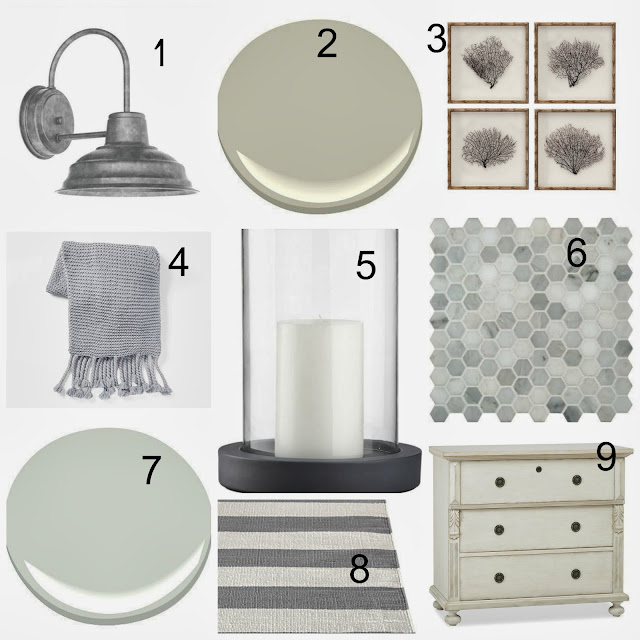
When we moved into our house, the base of the snack bar was covered with painted drywall. Not only was it less than inspiring, but it was totally impractical. Within a few weeks it was dirty, scuffed, and shabby looking. My first idea was to cover it with bead board, but then I thought about using board and batten. I loved the look, so I decided to give it a try. It turned out to be an easy and inexpensive project and the results were great. Take a look and then keep reading for the tutorial.
 |
| Before |
 |
| After |
Materials:
Lattice molding strips (pre-primed)
Outside corner molding (pre-primed)
Paintable caulk
Satin finish paint
Finish nail gun or construction adhesive
Level
The materials for this project are easy to find and inexpensive. Everything except the paint came from Home Depot. First, decide how many batten strips you want to use. I decided I wanted four strips. Next, measure the distance from the top of the baseboard to the bottom of the counter top. Measure at several different points to be sure you have accurate measurements. Lattice molding comes in 8' lengths. I needed 4 strips 36 1/4" long so I needed to buy two 8' pieces. They run about $4 each. I also needed two 36 1/4" pieces of outside corner molding, This also comes in 8' lengths, so I needed one of those. The outside corner molding ran about $8. I had all the cuts made in the store (they don't charge for doing this). I also picked up a tube of paintable caulk. I have a nail gun (my favorite all-time power tool), but if you don't, you'll also need to pick up a tube of construction adhesive. For the paint you want to get a satin finish latex or oil-based interior paint.
 |
| Lattice Molding |
Step 1: Apply lattice strips to the surface.
Decide how you want to space your battens. I ran the two outside pieces right next to the brackets holding up the counter top. Then I took the area in between and divided it into 3 sections. I ended up with 14" between each batten. Use a level to make sure the strips are vertical. Mark the location for each strip with a pencil. Then, using a nail gun or construction adhesive applied to the back of each strip, attach the batten strips to the surface, flush with the top edge of the baseboard molding, making sure to align the strips with your pencil marks. Depending on the type of baseboard molding you have, the lattice strips may be slightly thicker than the molding and overhang a bit. Don't worry, when it's all done it will look fine.
Step 2: Apply outside corner molding to the edges.
Next, to finish off the edges and to create the illusion of actual wood panels, apply the outside corner molding to both ends of the surface. This is best done with construction adhesive.
Step 3: Caulk all seams.
To make the project look neat and finished, you'll need to caulk all the seams between the batten strips and the surface, the baseboard, and the underside of the counter. Same thing with the outside corner pieces. Take your time and be sure not to leave any gaps.
Step 4: Paint.
The final step in the project is painting. For durability, I suggest using three coats. I decided to paint everything white to match the trim in the room...and I hated it. It was too stark and jarring. Then I repainted it in a softer white. Better, but still not what I was looking for. Finally I decided to go with something similar to, but slightly darker, than the wall color. I decided on Benjamin Moore Bennington Gray. Jackpot!
I couldn't be happier with the results. It was a great return on a small investment of time and money. It's a subtle detail, but it really finished off the room. Also, the satin finish paint, unlike the flat paint that had been used previously, is easy to keep clean. It stands up to scrubbing and it resists scuffs. No more grubby mess!
Take one more look at the "before"...
 |
Before
|
And now, the "after". Big improvement, don't you think?
|
 |
| After |
|



















































